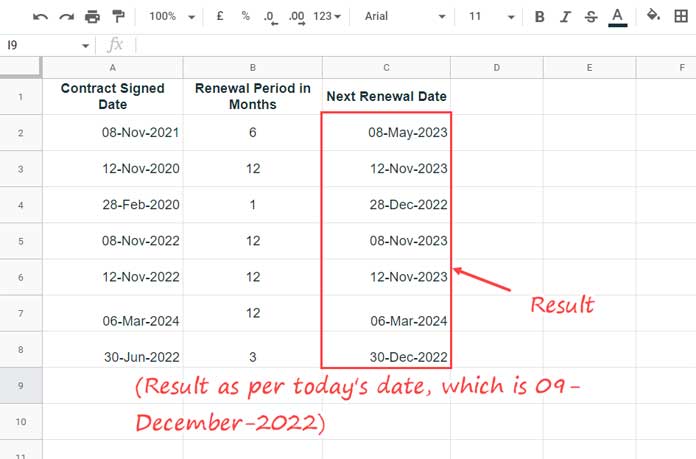You can use a formula or a custom named function to calculate the Next Renewal Date in Google Sheets based on a specified number of months for a subscription model.
Let’s say you’ve issued maintenance contracts to various parties, each with its own renewal interval.
In your spreadsheet:
- Column A is titled “Contract Signed Date” and contains the start dates of each maintenance contract.
- Column B is titled “Renewal Period in Months,” where you specify the auto-renewal interval (e.g., 1, 3, 6, or 12 months).
For example, if a contract was signed on 28-Feb-2020 and it renews every 12 months, and today is 09-Dec-2022, the next renewal date should be 28-Feb-2023.
Next Renewal Date: Sample Data, Formula, and Explanation
In this example:
- Column A: Contract Signed Dates
- Column B: Custom Month Intervals
- Column C: Resulting Next Renewal Dates

The formula to calculate the Next Renewal Date in Google Sheets is placed in cell C2. You can either drag it down manually or use an ArrayFormula to apply it across the entire column.
Master Formula:
=LET(
start, A2,
interval, B2,
monthsPassed, DATEDIF(start, TODAY(), "m"),
nextRenewal, EDATE(start, interval * (INT(monthsPassed / interval) + 1)),
TO_DATE(IFERROR(nextRenewal, start))
)Apply Formula to Entire Column:
To calculate the Next Renewal Date in Google Sheets for multiple rows at once, enter the following formula in cell C2:
=ArrayFormula(
LET(
start, A2:A,
interval, B2:B,
monthsPassed, DATEDIF(start, TODAY(), "m"),
nextRenewal, EDATE(start, interval * (INT(monthsPassed / interval) + 1)),
TO_DATE(IFERROR(nextRenewal, start))
)
)Formula Logic and Explanation
Let’s break it down:
DATEDIF(start, TODAY(), "m"): Calculates how many complete months have passed since the contract started.INT(monthsPassed / interval) + 1: Determines how many full renewal cycles have passed, then adds 1 to get the next upcoming one.EDATE(start, interval * ...): Projects the next renewal date forward based on the start date and number of months.TO_DATE(...): Formats the result as a date.IFERROR(..., A2): Returns the start date if an error occurs (e.g., empty or invalid input).
This approach ensures your renewal dates are dynamic and auto-updating based on the current date.
Custom Named Function to Get the Next Renewal Date
To make things easier, you can convert this into a Named Function.
Syntax:
NEXT_RENEWAL_DATE(startDates, intervals)- startDates – The cell or array with contract/subscription start dates.
- intervals – The cell or array with renewal periods (in months).
Examples:
- A single subscription starting on 08-Nov-2021 with a 6-month interval:
=NEXT_RENEWAL_DATE(DATE(2021, 11 , 8), 6)- Referencing cells A2 and B2:
=NEXT_RENEWAL_DATE(A2, B2)- For a full range:
=NEXT_RENEWAL_DATE(A2:A10, B2:B10)
To import this named function, make a copy of the following sample sheet and use the Named Function import option in Google Sheets:
Conclusion
This method is ideal for dynamically calculating the Next Renewal Date in Google Sheets based on flexible subscription models or contract intervals. Whether you’re managing subscriptions, maintenance contracts, or policy renewals, this approach ensures your dates are always up to date—automatically.





















